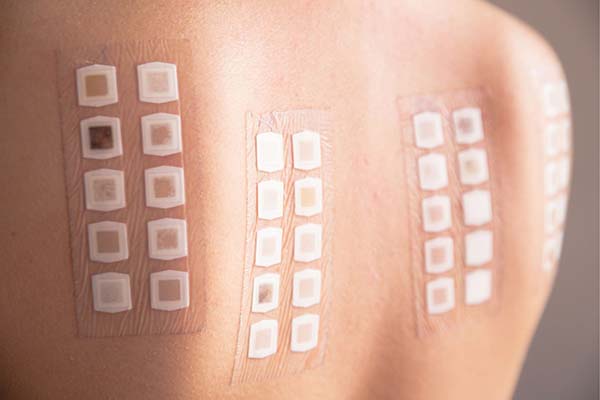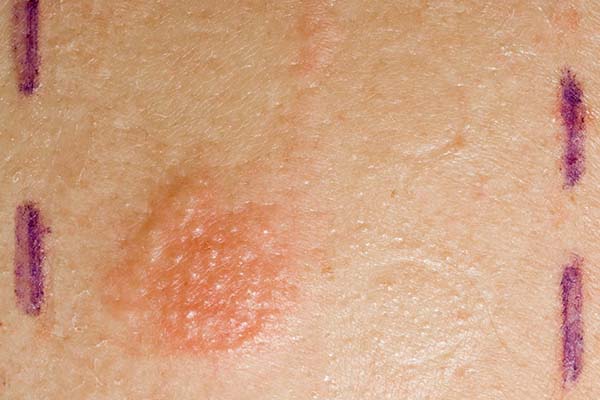What is Contact Dermatitis?
When a substance irritates the skin, it triggers a protective immune response which can cause the skin to become inflamed. The medical term for that reaction is “contact dermatitis.” If an individual is exposed to the irritant often, they can become allergic to it. An allergic reaction to a chemical or environmental substance is considered “allergic contact dermatitis.” It can develop over a long period of time as your body is repeatedly exposed to the irritant and creates a memorized response. You have a higher risk of developing an allergic reaction if you work or live in an environment where you are repeatedly exposed to a substance that irritates your skin.
Common items that often contain irritants include cosmetics, hair dye, fragrances, sunscreen and lip balm. Plants such as poison ivy, poison oak and poison sumac are notorious for outbreaks. Metals, especially nickel found in costume jewelry, snaps, zippers, earring posts and watch cases, are frequent culprits. Chemicals in latex gloves, balloons, pacifiers and medicines can cause reactions, too.
Clothing is frequently a source of irritation as your skin reacts to dyes and chemicals used to manufacture the garment. Synthetics are more likely than natural fibers to pose a problem because they don’t breathe as easily. And beware permanent press clothes, because chemicals like formaldehyde that are used to help reduce wrinkles are often a trigger.
For people with sensitive skin, it may help to choose fragrance-free moisturizers, soaps and cleansers, as well as clothing made from natural fibers in lighter colors that use less dye.
Symptoms
The most common symptom appears in the form of a red rash, concentrated where the irritant made contact with the skin. Contact dermatitis often starts in skin creases where clothing or an irritant makes the closest contact and where moisture from perspiration is more likely to gather. A warm or humid atmosphere creates a good environment for irritation to occur, especially when wearing tight-fitting clothing. Along with a rash, you may experience one or more of the following symptoms:
- Itching
- Tenderness
- Heat, burning or stinging skin
- Dryness
- Hives
- Blisters
- Pain
Diagnosis
Because it’s difficult to pinpoint the cause of the irritant, it’s important to consider clues. For instance, if a breakout is on your hands, consider if you were wearing rubber gloves. If the rash is on your ear, perhaps nickel in earrings is the cause, and if on your wrist, a watchband or bracelet may be the offender.
Thanks to medical advancements, a patch test can prove valuable and eliminate the guesswork. After reviewing your specific history and looking for clues about triggers, a patch test may be recommended by your allergist. Approximately 80 adhesive patches that contain small amounts of the most common irritants are gently placed on the patient’s back. The allergist will check your skin after 48 hours and again after another 48 hours, looking for reactions to any of the irritants, and in most cases will identify the source of the contact dermatitis.
Treatment
While avoidance of the irritating substance is best, once you have an outbreak and you have confirmed it is contact dermatitis, you can use over-the-counter antihistamines or anti-itch creams to soothe minor symptoms. For more severe cases, your doctor may prescribe corticosteroid topical creams or oral steroids. Although extremely rare, if an allergic contact dermatitis reaction triggers anaphylaxis, call 911 or administer injectable epinephrine.
The good news is that today, simple contact dermatitis patch testing can solve the mystery behind unexplained skin outbreaks by identifying the allergens and substances that cause them. Consult with your allergist today to learn what your triggers are so you can keep your skin calm and happy.
What is involved with the patch testing?
A wide variety of contact allergens are prepared for patch testing.
The testing involves three visits:
Day 1: Contact allergens are applied to your upper back and left in place for 48 hours.

Day 3: Patches are removed and your skin is examined for allergic reactions. Small red marks identify potential culprit allergies.

Day 4 or 5: Your skin is examined a second time for late-developing reactions.
If allergies are found, you are instructed to avoid the chemical(s) causing the skin reaction.
Chestnut Hill Allergy & Asthma Associates is a trusted provider of comprehensive allergy, asthma, and immunology care in the Philadelphia area. Their board-certified allergists specialize in diagnosing and managing skin allergies, offering patch testing for contact dermatitis to identify triggers such as fragrances, metals, preservatives, and other common allergens. This testing helps patients of all ages find relief from chronic rashes, itching, and irritation through accurate diagnosis and personalized treatment plans.
With convenient locations in Wyndmoor and Center City Philadelphia, Chestnut Hill Allergy & Asthma Associates serves surrounding communities including Lafayette Hill, Roxborough, Elkins Park, Germantown, Manayunk, Jenkintown, Plymouth Meeting, Conshohocken, Gulph Mills, and the Main Line area, encompassing Radnor, Wayne, Bryn Mawr, Ardmore, Bala Cynwyd, Narberth, Fort Washington, Ambler, Spring House, Willow Grove, and Abington.

